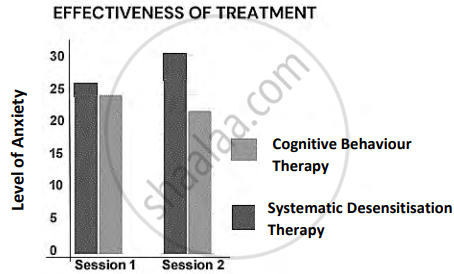Advertisements
Advertisements
प्रश्न
|
Ten participants, all having a phobia of spiders, were divided into two groups for a study that aimed at determining the effectiveness of Cognitive Behaviour Therapy (CBT) and Systematic Desensitisation. Each group underwent two sessions of each therapy. At the end of every session, the effectiveness of therapies was measured based on a questionnaire on Anxiety, which was filled by the participants. The responses of the participants have been depicted in the graph given below.
|
- Refer to the graph shown above and determine which treatment was more effective. Contrast the effectiveness of Cognitive Behaviour Therapy (CBT) and Systematic Desensitisation. (3)
- Discuss any two symptoms and any two causes of Phobias. (4)
उत्तर
- The results from the two sessions in the bar graph show that Cognitive Behaviour Therapy (CBT) was more effective in the treatment of the phobia than Systematic Desensitisation.
Cognitive Behaviour therapy involves identifying and changing distorted and maladaptive patterns of thought. Systematic desensitisation involves gradual exposure to an anxiety-producing stimulus that is paired with relaxation in order to eliminate the response of the anxiety-causing phobia. It is a therapy under Classical Conditioning. Systematic Desensitisation. -
- Symptoms of phobia:
- The fear is unreasonable or excessive, but the person is unable to help himself or herself from being rational.
- The phobic situation is avoided otherwise it is endured with great distress.
- It causes personal distress and impaired functioning.
- The anxiety associated with phobias is not related to other psychological disorders.
- Causes of Phobia:
Biological causes of phobias:- Genes: Specific genes may affect anxiety and fearfulness.
- Chemical Imbalance: An imbalance in the brain chemical Serotonin could be a factor. Serotonin, a neurotransmitter, helps regulate mood and emotions, among other functions. People with phobic disorders may be extra sensitive to the effects of serotonin.
- Fear responses: The limbic system of the brain is involved in controlling strong emotions, motivation and learning. The amygdala may play a role in controlling the fear response. People who have an overactive amygdala may have a heightened fear response, causing increased anxiety in social and specific situations.
- Behavioural perspective: explains anxiety in phobic disorders as a learned response to stress. Operant A young girl is bitten by an insect. When she next sees one, she is frightened and runs away - a behaviour that relieves her anxiety and thereby reinforces her avoidance behaviour.
- Classical conditioning: associate neutral stimuli with strong emotional reactions. For example, an individual may develop a phobia of buzzing noises such as those made by bees after being stung by a bee or wasp.
- Social Cognitive view: Observational learning leads to fears typical of phobias. For example, a little girl may have developed a fear of high places because she may have seen or heard of people who were afraid of high places.
- Symptoms of phobia:
APPEARS IN
संबंधित प्रश्न
Answer the following question briefly:
Who put forward the theory of moral development?
Answer the following question:
Briefly explain what is meant by gender identity.
Answer the following question briefly:
Explain the pre-conventional stage of morality.
Describe concrete cognitive development during childhood.
All individuals have a certain knowledge of themselves and some beliefs about their own characteristics. What is this known as?
In a study on Moral Development, subjects were presented with a hypothetical situation involving conflicting moral values or moral dilemmas. They were asked to make judgements on this situation and give their reasoning.
- Who proposed the Theory of Moral Development referred to above?
- Briefly explain each of the following stages of Moral Development:
- Obedience and Punishment Orientation.
- Good girl-Good boy Orientation.
- Social Contract Orientation/Legalistic Orientation.
| Shireen and Rafi are siblings aged five and six years respectively. They like to play at home pretending as king and queen. They wear their mother's gowns and decorate the chair like a throne. They believe that their toy horse is real and ride it. They want their mother to play with them and get upset when she refuses to play. They do not understand that their mother is tired and needs rest. |
- Name the stage of Cognitive Development that Shireen and Rafi are going through.
- Discuss any six features of the stage of Cognitive Development that Shireen and Rafi are experiencing.
Observe the image shown below and identify the stage of cognitive development.

Study the relation between the first two words and then fill in the fourth word.
Good boy-Good girl orientation : Conventional level : : Universal ethical principle orientation : ______.
| Ananta, aged 8 years and her sister Rashmi, aged 4 years, are given a set of objects like coloured marbles, toy animals and plastic fruits. They are asked to sort and classify these objects. Ananta can sort the objects based on colour, shape, and size easily. However, Rashmi cannot sort these objects based on their features. |
- According to Piaget’s theory, what stages of cognitive development are Ananta and Rashmi currently in? (2)
- Contrast the stages of cognitive development of Ananta and Rashmi on any two bases. (2)

